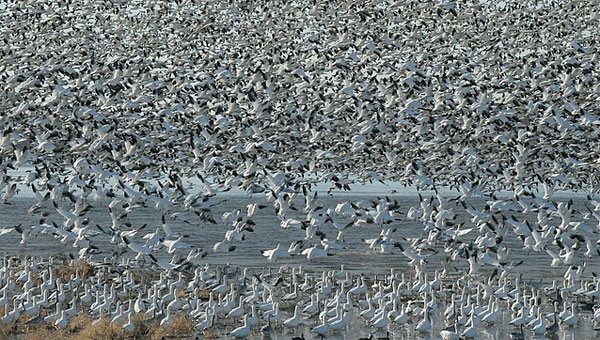Just when you though the giant armed, saddle humped, therizinosaur mimicking
Deinocheirus could not get any weirder with the reveal of the skull the fossil record throws up a proverbial hail mary that shows us all what a crackpot evolution can be. It has, for all intents and purposes, a duckbill.
Nestled somewhere between an ostrich and a duck, this new skull recently repatriated to Mongolia but currently unpublished, is sure to stir up quite a bit of speculation regarding the lifestyle of this perplexing chimera that has haunted the minds of dinosaur lovers for decades now. So let me add my antediluvian salad take on how this Mesozoic mash-up may have lived.
So far this depiction (used with permission) of
Deinocheirus by Andrey Atuchin is my favorite so far. What strikes me is how real the Deinocheirus looks - not some bizarre amalgamation of different animals like many other renderings depict. What I also noticed was the environmental context the animal was put in - a wetland setting. Now I had always thought of the Nemegt as sort of a wetter desert and many depictions of it suggest such a mosaic of sand dunes with some forest cover. Turns out I was only partially right. The Nemegt was an endorheic basin - water flowed into the system but not out. Even in very arid climates such a confluence of watershed and topography can create very lush habitats. A good modern proxy may be the Okavango Delta of Botswana which is seasonally flooded and replete with all the classic megafauna of Africa but otherwise in an arid climate.
![]() |
| Okavango Delta. Botswana. wiki |
Now with this wetland environment and duckbill head in mind, it begs the question: was
Deinocheirus a dabbler? Obviously the skull needs to be worked upon, finite element analysis performed etc etc. And let us not get carried away by the shape of the skull because we all know what happened with the supposedly "semi-aquatic, dabbling" duck bill dinosaurs... But are we looking at the largest waterfowl of all time?
![]() |
| Magpie Goose. wiki |
We don't tend to equate large size with making a living as a dabbler of aquatic vegetation. In modern ecosystems this niche is primarily occupied by birds of the order Anseriformes - your ducks, geese, swans etc etc - which as a group were just coming into their own in the Cretaceous but doubtless not as diverse or abundant as they are today. And of course we do not have multi ton waterbirds or dabblers of any sort in this size range. Does this imply such a lifestyle could not have provided for a huge dabbler in the past? I say:
why not? Consider the size of migratory flocks of waterfowl. The stories of how huge flocks of ducks and geese blocked out the sun is stuff of legend and lore in the not to distant past in America. And if you start to look at the huge amount of biomass that flocking waterfowl represent and start to look at them not so much as individuals but as a giant super-organism it starts to become more and more negotiable in imagining dabblers on dinosaurian size scales. However unlike the situation today where a temperate, seasonal climate necessitates migration of waterfowl flocks to find adequate food - the more equatable, balmy climes of the Mesozoic may have offered more opportunity for dabblers to exist in one area permanently.
![]() |
| (c) Gerry Dewaghe |
And if we start to consider the possibility
Deinocheirus acting as a mega-dabbler we should also start to explore what food stuffs it was targeting. The roots, bulbs, and tubers of emergent vegetation are nutritious/starchy foodstuffs and often consumed by aquatic birds. The big clawed hands of
Deinocheirus may have even assisted with such endeavors. Suspended organic matter in the water, small aquatic organisms offer another avenue of dietary choice. But if I could suggest one food item in particular that could offer sustenance for a huge dabbler on the scale of
Deinocheirus it would be the aquatic fern
Azolla.
![]() |
| Azolla. Duane Nash |
Now I have talked about
Azolla before
here but what you should know is that this floating, aquatic mat forming fern is a bit of a super-plant. It spreads wildly, growing fast, assisted by N-fixing bacteria it can colonize waters devoid of nutrients. It is relatively nutritious with good levels of protein, vitamins, minerals, essential fatty acids and has received attention as a food crop for domestic animals. Although we do have good records of
Azolla going back pretty early in the Cretaceous I can not find any reference to
Azolla in the Nemegt (but reference to the paleoflora of the Nemegt is sparse anyways). There is evidence for
Azolla in India and North America more or less bookending the Nemegt between the two land masses and given how well aquatic plants spread and disperse it would not be surprising for
Azolla to be part of the flora of the Nemegt. And if you had acres upon acres of flooded landscape, in a landscape without the grasses and papyrus that dominate the Okavango,
Azolla seems like a good candidate for such an environment creating huge amounts of biomass supporting
Deinocheirus, and probably other, dinosaurs.
![]() |
| Azolla filculoides. wiki |





